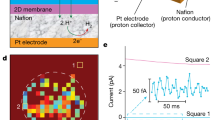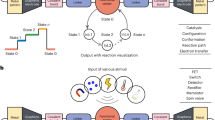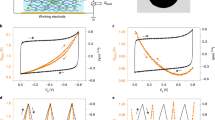Abstract
Isolated, atomically thin conducting membranes of graphite, called graphene, have recently been the subject of intense research with the hope that practical applications in fields ranging from electronics to energy science will emerge1. The atomic thinness, stability and electrical sensitivity of graphene motivated us to investigate the potential use of graphene membranes and graphene nanopores to characterize single molecules of DNA in ionic solution. Here we show that when immersed in an ionic solution, a layer of graphene becomes a new electrochemical structure that we call a trans-electrode. The trans-electrode’s unique properties are the consequence of the atomic-scale proximity of its two opposing liquid–solid interfaces together with graphene’s well known in-plane conductivity. We show that several trans-electrode properties are revealed by ionic conductance measurements on a graphene membrane that separates two aqueous ionic solutions. Although our membranes are only one to two atomic layers2,3 thick, we find they are remarkable ionic insulators with a very small stable conductance that depends on the ion species in solution. Electrical measurements on graphene membranes in which a single nanopore has been drilled show that the membrane’s effective insulating thickness is less than one nanometre. This small effective thickness makes graphene an ideal substrate for very high resolution, high throughput nanopore-based single-molecule detectors. The sensitivity of graphene’s in-plane electronic conductivity to its immediate surface environment and trans-membrane solution potentials will offer new insights into atomic surface processes and sensor development opportunities.
This is a preview of subscription content, access via your institution
Access options
Subscribe to this journal
Receive 51 print issues and online access
$199.00 per year
only $3.90 per issue
Buy this article
- Purchase on Springer Link
- Instant access to full article PDF
Prices may be subject to local taxes which are calculated during checkout





Similar content being viewed by others
References
Geim, A. K. Graphene: status and prospects. Science 324, 1530–1534 (2009)
Reina, A. et al. Large area, few-layer graphene films on arbitrary substrates by chemical vapor deposition. Nano Lett. 9, 30–35 (2009)
Reina, A. et al. Growth of large-area single- and bi-layer graphene by controlled carbon precipitation on polycrystalline Ni surfaces. Nano Res. 2, 509–516 (2009)
Ferrari, A. C. et al. Raman spectrum of graphene and graphene layers. Phys. Rev. Lett. 97, 187401 (2006)
Sint, K., Wang, B. & Kral, P. Selective ion passage through functionalized graphene nanopores. J. Am. Chem. Soc. 130, 16448–16449 (2008)
Zwolak, M., Lagerqvist, J. & Di Ventra, M. Quantized ionic conductance in nanopores. Phys. Rev. Lett. 103, 128102 (2009)
Storm, A. J., Chen, J. H., Ling, X. S., Zandbergen, H. W. & Dekker, C. Fabrication of solid-state nanopores with single-nanometre precision. Nature Mater. 2, 537–540 (2003)
Hall, J. E. Access resistance of a small circular pore. J. Gen. Physiol. 66, 531–532 (1975)
Li, J., Gershow, M., Stein, D., Brandin, E. & Golovchenko, J. DNA molecules and configurations in a solid-state nanopore microscope. Nature Mater. 2, 611–615 (2003)
Zwolak, M. & DiVentra, M. Physical approaches to DNA sequencing and detection. Rev. Mod. Phys. 80, 141–165 (2008)
Alexiadis, A. & Kassinos, S. Molecular simulation of water in carbon nanotubes. Chem. Rev. 108, 5014–5034 (2008)
Werder, T., Walther, J. H., Jaffe, R. L., Halicioglu, T. & Koumoutsakos, P. On the water-carbon interaction for use in molecular dynamics simulations of graphite and carbon nanotubes. J. Phys. Chem. B 107, 1345–1352 (2003)
Bard, A. J. & Faulkner, L. R. Electrochemical Methods. Fundamentals and Applications 2nd edn, Ch. 13, 534–579 (Wiley & Sons, 2001)
Holt, J. K. et al. Fast mass transport through sub-2-nanometer carbon nanotubes. Science 312, 1034–1037 (2006)
Liu, H. et al. Translocation of single-stranded DNA through single-walled carbon nanotubes. Science 327, 64–67 (2010)
Branton, D. et al. The potential and challenges of nanopore sequencing. Nature Biotechnol. 26, 1146–1153 (2008)
Hoogerheide, D. P., Garaj, S. & Golovchenko, J. A. Probing surface charge fluctuations with solid-state nanopores. Phys. Rev. Lett. 102, 256804 (2009)
Schneider, G. F. et al. DNA translocation through graphene nanopores. Nano Lett 10.1021/nl102069z (published online 7 July 2010)
Merchant, C. A. et al. DNA translocation through graphene nanopores. Nano Lett 10.1021/nl101046t (published online 23 July 2010)
Hille, B. Ion Channels of Excitable Membranes 3rd edn, Ch. 1 1–22 (Sinauer Associates, 2001)
Kasianowicz, J. J., Brandin, E., Branton, D. & Deamer, D. W. Characterization of individual polynucleotide molecules using a membrane channel. Proc. Natl Acad. Sci. USA 93, 13770–13773 (1996)
Acknowledgements
This work was funded by a grant (number R01 HG003703) to J.A.G. and D.B. from the National Human Genome Research Institute, National Institutes of Health.
Author information
Authors and Affiliations
Contributions
Graphene samples were grown by J.K. and A.R. Experiments and calculations were performed by S.G. Other activities, including data interpretation, conclusions and manuscript writing, were performed collaboratively at Harvard University by S.G., W.H., D.B. and J.A.G.
Corresponding authors
Ethics declarations
Competing interests
The authors declare no competing financial interests.
Rights and permissions
About this article
Cite this article
Garaj, S., Hubbard, W., Reina, A. et al. Graphene as a subnanometre trans-electrode membrane. Nature 467, 190–193 (2010). https://doi.org/10.1038/nature09379
Received:
Accepted:
Published:
Issue Date:
DOI: https://doi.org/10.1038/nature09379
This article is cited by
-
High durability and stability of 2D nanofluidic devices for long-term single-molecule sensing
npj 2D Materials and Applications (2023)
-
Towards the realisation of high permi-selective MoS2 membrane for water desalination
npj Clean Water (2023)
-
Linking atomic structural defects to mesoscale properties in crystalline solids using graph neural networks
npj Computational Materials (2022)
-
Multifunctional graphene heterogeneous nanochannel with voltage-tunable ion selectivity
Nature Communications (2022)
-
Cation-selective two-dimensional polyimine membranes for high-performance osmotic energy conversion
Nature Communications (2022)
Comments
By submitting a comment you agree to abide by our Terms and Community Guidelines. If you find something abusive or that does not comply with our terms or guidelines please flag it as inappropriate.



